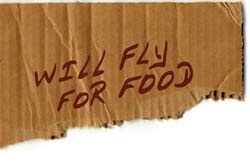|
|
 |
| SW Aviator Magazine is available in print free at FBOs and aviation-related businesses throughout the Southwest or by subscription. |

|
 |

|
 |
 |
 |
|
The web's most comprehensive database of Southwest area aviation events.
|

|
 |

|
 |
|
Featured Site:
|
|
|
 |
|
A continuosly changing collection of links to our favorite aviation related web sites.
|

|
 |

|
 |
 |
|

 |
 |
A Gourmet Journey through the Southwest

|
|
By Fletcher Anderson
I don’t mean even for a moment to undervalue the proverbial Hundred Dollar Hamburger. But there are also times when you have been busy at work, or on the road and away from the family, and are tired and just really look forward to a quiet meal at home. However, just like with the Hundred Dollar Hamburger, the miracle of the airplane can enhance this experience as well.
Perhaps closer to the truth, dinner at home can be employed as yet another transparently obvious excuse to go flying. An example from personal experience comes to mind.
It was early fall — the time of year when the weather in our part of the world is at its very best. The days are growing shorter, but we still have long pleasant evenings. High in the mountains the aspen leaves are reaching the peak of their color. Out in the desert the temperatures are finally just right for a comfortable hike, while the water temperature in all the little creeks is still fine for a cool swim. Geese are migrating south. In the valleys the fall harvest is coming in, and there is a pleasant fragrance of native foods cooked over open fires. There have been a few early season storms, precursors of a winter sure to come; but right now we have a perfect Indian Summer. Life doesn’t get any better than this. Who would want to live anywhere else?
But while I am very much at home in the Southwest, today I am not yet "at home" home. I have just dropped off charter passengers at Albuquerque International Airport in the Duke City. I call Shelby, my company dispatcher (who is the same person as my wife — it’s a very small company), to report departing for Telluride and home.
"Darling, would you mind picking up something for dinner?" Shelby asks. This normally means going by the store on the drive home from the airport, but wouldn’t she be delighted if I made just a bit more effort and did something really special today? After all, not only does the Southwest have better weather and scenery than anywhere else, it also has much, much better food.
For instance, what have all those little clusters of motorists pulled off the New Mexico highway for? They know that chile, not variety, is the spice of life, and the smoky flavor and subtle earthy aftertaste of those big long green chilies grown all over New Mexico occupies a special place in gastronomic heaven. When they ripen, farmers take a few right off the field straight into a wire-cage propane powered roaster and set up beside the highway. At the peak of the harvest, they are found everywhere. There is a certain elegance in getting them this way; a direct connection to the soil, the season, and the local traditions that produced them.
So, to please my dispatcher, on the way home I land at Taos (SKX N36 27.49’ W105 40.35), elevation 7091 feet with a 5800 foot long runway aimed into the afternoon southwest breeze, where I borrow the crew car to head up the highway toward the Taos Pueblo. It has been too short a flight to purchase courtesy fuel. Perhaps the line crew would like some extra chilies? Let me grab a huge bundle of them wrapped in newspaper, and while I’m at it, maybe a big braided string of ajo and a garland of dried red chilies as well. As I throw this fiery load in the back seat of the plane, I hope my eyes don’t start watering.
|
 |
Since I’m doing this right, I need (what else?) beans for the main course. If I fly Victor airways home instead of directly over the mountains, I will cross the Dove Creek VOR (about 50 miles west of Telluride, 40 miles north of Cortez, Colorado). The southwest end of Dove Creek’s 4200 foot long, but not very smooth, dirt runway (8V6- 37 45.83N, 108 53.32W) is about one city block from the warehouse of the Adobe Milling Company, the world’s largest pinto bean distributor. Not for nothing does Dove Creek proclaim itself "The Pinto Bean Capital of the World!" Adobe Milling also sells some excellent salsa, which I can pour over the roasted green and the dried red chilies, producing absolutely no one’s idea of a balanced meal.
So... I have gathered the definitively perfect core ingredients of an outstanding simple regional meal for my wife, and I am only half an hour from home. But wait — I am overlooking the Holy Trinity of the Southwestern aboriginal diet. That would be corn, beans, and squash. Most of the corn in America comes from the Midwest, but the best fresh ears of Sweet Corn come from Olathe, Colorado. As with chile in New Mexico, at the peak of the harvest there is just too much fresh corn to ship, so growers begin selling it out the back of pickup trucks along the highway. There is a crop duster’s private strip right in Olathe, but I’ll land at the very well maintained public use dirt runway of Hawkins Field just up the road in Delta, Colorado (D17- 38 45.44N, 108 08.87W). If I lived here, I’d be home now; and there are runway access lots for sale. Instead, I am still half an hour away from my home, just in a new direction. But it isn’t dark yet, and nowhere near dinnertime. I purchase a bag of ears of fresh corn from the farmer who usually sets up in the large parking lot right at the airport and get back in the plane.
Uh-oh, what about meat? When I was growing up, Colorado had more cattle than people. Those days are long gone, but the vast feed lots of Greeley, Colorado, north of Denver, still move cattle by the hundreds of thousands into packing plants larger than any of the towns I have visited on this trip, shipping prefabbed burgers by the millions of tons. "Go west young man!" urged the town’s namesake Horace Greeley. But wait, that’s about 190 nautical miles northeast of here over the Continental Divide and out onto the Great Plains. Maybe I shouldn’t limit myself to beef.
Reaching a little further back towards the region’s roots, buffalo might be a nice exotic. I could head over to Gunnison, Colorado (GUC- 38 32.03N, 106 55.99W), just half an hour to the east, where there is a buffalo herd. Even more exotic would be dropping in at Montrose, Colorado (MTJ- 38 30.53N, 107 53.63W), where Storm King Ranch raises elk commercially just fifteen or twenty minutes south of the airport. This is a tough choice, but tonight I feel like buffalo. After all, what difference does an extra fifteen minutes flight make?
…And since I’m already headed that direction, maybe I could grab something for tomorrow’s breakfast too (I’m sure my wife would approve). I am thinking now in terms of a cantaloupe or a honeydew melon. I am thinking of Rocky Ford, Colorado on the Arkansas River, the self-proclaimed "Melon Capital of the World," which is the second World Food Capital on this flight. How cosmopolitan! This leg is getting a little far afield, but then I don’t surprise my wife like this every evening. Won’t she be pleased?
Heading to the east 25 miles out of Gunnison, I cross the 11,300 foot high Monarch Pass, one of the more benign ways to get over the Continental Divide in a small plane, though on a windy day I might try Cochetopa pass, one big mountain further to the south. Monarch Pass remote AWOS (124.175) will have the weather. From there it is less than 60 miles flying down the Arkansas River Valley to the appropriately named Melon airport, (LHX- 38 03.08N, 103 30.64W). See how much easier a long trip is if you break it up into small segments? Rocky Ford is way out there on the Wichita sectional chart. Now I am pushing the eastern limits of the Southwest, and I have begun to make this a very late dinner. But after all, waiting does improve the appetite. And what brings a perfect end to a long day? A cold beer!
St. Louis, Missouri is just one more sectional chart east, but that is clearly too far for this trip, and certainly not in the Southwest. A bit out of the brewery mainstream, but back in the Southwest and a perfect compliment to this particular meal, is Crazy Ed’s Cave Creek Beer, which has a tiny little pickled chile in each bottle. I know the concept sounds worse than nauseous; caustically, inflammably nauseous in fact, but trust me — the subtle earthy aftertaste of the chile is delightful. The late Edward Abbey could just guzzle this stuff, but I think the rest of us might prefer to slowly savor a single really cold one right out of the bottle. No really! Let’s get back in the plane.
Cave Creek is in the northern suburbs of Phoenix, Arizona, almost, but not quite within convenient walking distance of the private Carefree Sky Ranch Airpark (18AZ- 33 49’ 05.14N, 111 53’ 52.53W), or easy rental car distance from Scottsdale (SDL N33-37.37, W 111-54.63). But Scottsdale is now hundreds of miles the other side of our starting point in Albuquerque, a whole day’s flight away in a small plane. Sorry- that’s just too far for this particular flight. I really should have planned this trip better, and now it is already several hours too late to make the half-hour after sunset curfew at Telluride. Oh, well, I guess we might as well fly on into the night. A beer is really best after sundown anyway.
You didn’t like the beer with a pickled chile pepper in it? What? Let me finish yours. Once you get used to the taste, it really is worth the flight. Or perhaps the flight is worth the beer. Anyway, sorry — I thought you’d love it. Perhaps a cerveza might be better than just a beer? Once again, we are in luck! Unroll the sleeping bags under the wing. We need to rest twelve hours after that last beer before we can fly a full day out of Arizona into Old Mexico for the next one.
When Maxmillian of the Holy Roman Empire came over to rule Mexico two centuries ago, he brought along the two things no Austrian Emperor could live without. That would be Tyrolian Brass bands, whose Om-Pah music metamorphosed into Marriachi; and beer making, which has matured to become at least the equal of the parent brews back in the Alps. Now I’m thinking of a frosty Cerveza Pacifico, mostly because the city of Mazatlan, where it is brewed, is right on the beach… Isn’t it great to have an airplane so that we can run all these important errands?
A cell phone call from Shelby jolts me back to reality. I’m still in Albuquerque, and she’s forgotten to ask me to also pick up some milk. Okay, the shopping flight was a great idea, but the schedule is too tight and the plane too small to carry all that stuff. Maybe just this one time supermarket food will have to do for dinner. We can spread the other ingredients over several future flights and meals.
I do just have time though to borrow the crew car, and see if there is some fresh green chile for sale closer to this airport.
Fletcher Anderson and Shelby Evans operate Mountain Aviation Services, a flight instruction, aerial photography, and single engine air taxi business based in Telluride, Colorado. Fletcher’s popular textbook "Flying the Mountains" is in bookstores now. |
Click here to return to the beginning of this article.  |
|